Yves GARY Hits: 3689
Category: 1871 : CHALLENGE N°2
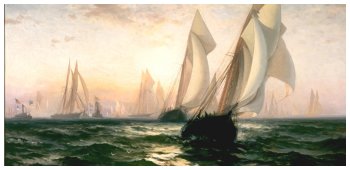 Another Victory for the American Yacht Columbia. The Livonia Defeated on the Open Course
Another Victory for the American Yacht Columbia. The Livonia Defeated on the Open CourseThe second race was appointed to be sailed on the 18th October, when a fresh N.N.W. breeze gave promise of better sport.
The course this time was to be out at sea twenty miles and back, and towards 10h. a.m. the wind freshened when the committee of five held a consultation, and doubting the ability of the Dauntless to compete with the Englishman in the stiff breeze then blowing, they thought it best to make a sure thing of it by selecting the Columbia, which had proved herself equal to the work in the previous race, so the committee-boat steamed up alongside of the Columbia, and hailing her informed Rear-Commodore Osgood that he was to start.
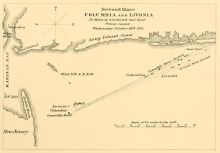 The owner of the Columbia was nothing loth to again measure speed with the crack yacht of England, but thought it was rather hard on Mr. Ashbury. However, there was no appeal from the decision of the committee, so balloon topsails were at once the order of the day on board of the Columbia, while the Dauntless hauled her balloon down, and setting her working topsail prepared to take things easy. The steamer Lackawanna was then ordered to steam out twenty miles E.N.E. and take up a position off New Inlet, and then after visiting both of the contestants and giving them their parting orders the William Fletcher steamed up and took a position just to the eastward of the light-ship.
The owner of the Columbia was nothing loth to again measure speed with the crack yacht of England, but thought it was rather hard on Mr. Ashbury. However, there was no appeal from the decision of the committee, so balloon topsails were at once the order of the day on board of the Columbia, while the Dauntless hauled her balloon down, and setting her working topsail prepared to take things easy. The steamer Lackawanna was then ordered to steam out twenty miles E.N.E. and take up a position off New Inlet, and then after visiting both of the contestants and giving them their parting orders the William Fletcher steamed up and took a position just to the eastward of the light-ship.
Then the two competing yachts stood on to the southward on the starboard tack for a while, and went round and dressed for the race by setting balloon fore-gaff topsails, jib topsails, and main topmast-staysail. Then ensued a weary waiting, the committee fearing that with the fresh breeze then blowing the yachts would overrun the mark-boat before she reached her station, delayed till the last moment before they gave the signal. 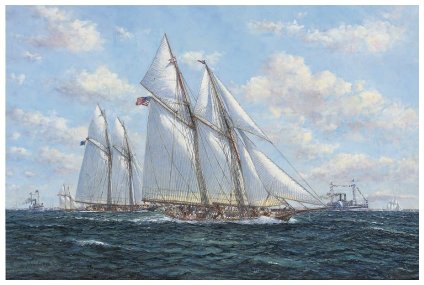 The two yachts, meanwhile, lay with their head sheets to windward, the Columbia just to the windward of the Livonia. At last, when the patience of everybody was worn out, at 11h. 55m., the flags were lowered as the preparatory signal, to the intense delight of everyone. Again another delay, until at 12h, noon exactly the flags again went down, and the whistle blew for the yachts to start. They did not wait to maneuver, but at once the helm was put up on board of the Livonia, and the beautiful vessel fell gracefully off; and as the wind obtained full power on her sails she yielded to its influence, and sprang forward on her course. The Columbia waited for a moment that her rival might get well out of her way, and then she too was kept off towards the crossing line. The boats reached it at a tremendous pace, with the wind four points on the quarter, and everything pulling fairly. Time crossing the line, Livonia 12h 3m 21s Columbia 12h 5m 36s.
The two yachts, meanwhile, lay with their head sheets to windward, the Columbia just to the windward of the Livonia. At last, when the patience of everybody was worn out, at 11h. 55m., the flags were lowered as the preparatory signal, to the intense delight of everyone. Again another delay, until at 12h, noon exactly the flags again went down, and the whistle blew for the yachts to start. They did not wait to maneuver, but at once the helm was put up on board of the Livonia, and the beautiful vessel fell gracefully off; and as the wind obtained full power on her sails she yielded to its influence, and sprang forward on her course. The Columbia waited for a moment that her rival might get well out of her way, and then she too was kept off towards the crossing line. The boats reached it at a tremendous pace, with the wind four points on the quarter, and everything pulling fairly. Time crossing the line, Livonia 12h 3m 21s Columbia 12h 5m 36s.
Then the race began in earnest, with the course E.N.E., wind W.N.W., a good breeze and a strong easterly tide. The Livonia a point on the Columbia's lee bow and a half mile distant. Those who expected that the Columbia would at once overhaul the Livonia were doomed to disappointment. For a time the space was about even, but then it was noticed that the English boat was opening the gap and at 12h 30m she had increased her lead fully a quarter of a mile. Then the wind freshened, and the fair weather boat Columbia, as everyone has called her because she beat everything in fair weather, began to gain on her formidable opponent. It was very slow scarcely perceptible but still it was a gain. The other yachts of the fleet had by this time taken their positions in the line, the Palmer and Dauntless on the Columbia's weather quarter, with the Dreadnaught far to leeward on her lee quarter, and the Tarolinta a long distance astern.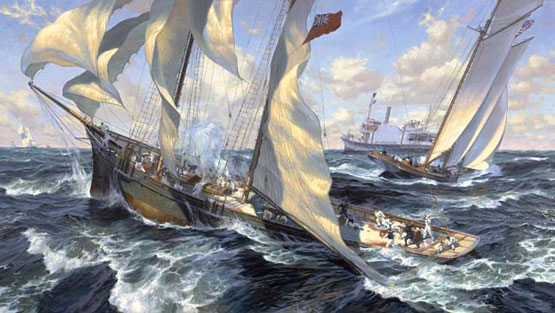 At 12h 35m the Columbia carried away her main topmast staysail sheet and had to take it in. In five minutes another sheet was rove and the sail re-set, but during the interval the flying Englishman again made a larger space between himself and the Columbia. But the wind increased, and the Columbia would not be denied, but crept on and on until as the Livonia neared the mark boat the Columbia was close on her lee quarter. The yachts were not restricted as to the manner of turning, and as the Livonia passed to windward and wore round it the Columbia shot across her stern between berand the mark steamer and tacked, gaining by this maneuver a position on the Livonia's weather quarter for the run home. The time of turning the mark was Livonia 1h 20m, Columbia 1h 21m 40s.
At 12h 35m the Columbia carried away her main topmast staysail sheet and had to take it in. In five minutes another sheet was rove and the sail re-set, but during the interval the flying Englishman again made a larger space between himself and the Columbia. But the wind increased, and the Columbia would not be denied, but crept on and on until as the Livonia neared the mark boat the Columbia was close on her lee quarter. The yachts were not restricted as to the manner of turning, and as the Livonia passed to windward and wore round it the Columbia shot across her stern between berand the mark steamer and tacked, gaining by this maneuver a position on the Livonia's weather quarter for the run home. The time of turning the mark was Livonia 1h 20m, Columbia 1h 21m 40s.
But the wind was still on the increase, and it soon became apparent that sharp, on a wind as the boats now were, some of the racing kites must come in. On the Columbia balloon fore gaff-topsail and main-topmast staysail bad been taken in before reaching the mark-boat, and now the main topsail and jib-topsail had to come off her, and so much had the wind freshened that no working topsails were set in their places, and under her four lower sails the Columbia went bounding along like a race-horse, eating ahead of the Livonia at every jump. The latter started nothing except her jib-topsail which split and had to be taken in. The other yachts did not try to round the mark, but tacked before reaching it, the Palmer first, astern of the Livonia, with the Dreadnaught astern of her. The Dauntless tacked ahead of the Columbia, having both main-topmast staysail and balloon main-gaff-topsail set and kept off across the stern of the Livonia to assume a position on her lee quarter, 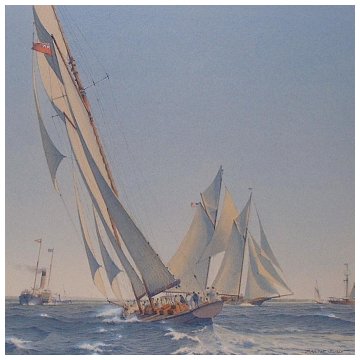 but her staysail and fore-topsail both got jammed and ere she could get them on deck both the Palmer and Dreadnaught came up and passed her. The boats all headed in W.b.S. The wind still freshened and the squalls became heavy. At 1h 43m the Livonia took in her jib and set a smaller one. The Dreadnaught was doing remarkably well and at this time appeared to be gaining on the whole fleet.
but her staysail and fore-topsail both got jammed and ere she could get them on deck both the Palmer and Dreadnaught came up and passed her. The boats all headed in W.b.S. The wind still freshened and the squalls became heavy. At 1h 43m the Livonia took in her jib and set a smaller one. The Dreadnaught was doing remarkably well and at this time appeared to be gaining on the whole fleet.
At 2h 5m the Columbia, being on the weather bow of the Livonia, took in her flying jib. At 2h 7m the boats were struck with a sharp squall from the north-west, and the Columbia had to take in her fore-sail and the Livonia had to let her main-topsail come down. But the plucky Englishman still hung on to his square-headed fore-topsail determined to out carry, if he could not out-sail his opponents, though we question the policy of the step. She took in both her jib and fore-staysail successively and set smaller ones in their places, and then hung on to the rest of her canvas, determined to either carry or drag it. It was a pretty sight to see her at this time, as, with her rail completely under and the spray flying in clouds over her weather bow, she struggled along, painfully trying to keep up with her fleet antagonist, the Columbia, which was going alone under mainsail and jib alone having, taken in her flying jib, so as not to risk carrying anything away when the race was all her own. At 2h 15m the Palmer had to yield to the breeze and take in her foresail. The Dreadnaught still carried on under main foresails and jib but laying down lee rail under, and showing that there was good go in her when she had a chance. The Livonia did wonderfully well, and it is but simple justice to say that there is not a boat in the New York Yacht Club that could have kept ahead of her, except the Columbia unless it be the Sappho. At 2h 25m the Columbia had to set her reefed fore-sail to keep the Englishman astern. At 2h 34m the light ship was sighted from the Columbia a point on the lee bow, and the straining yachts were able to keep off and start their sheets a little. The Columbia at once set her flying jib again. The rest of the fleet were nowhere and the two contestants had the field all to themselves; the Livonia still having on everything, whole fore and mainsails, staysail, and jib, with immense square-headed fore top-sail, and it seemed as if her topmast must go over her side. But everything held on and not a stitch of canvas was taken off her till she had passed the line, which they did as follows:

After passing both yachts set their colors for a steamer as the wind was ahead and increasing every moment. The Fletcher came after some delay and courteously attended the Englishman first. Then the steam yacht Herald took hold of the Columbia and pulled away at her for a time, but the wind increased to a gale and the yacht was obliged to let go and under double-reefed mainsail and jib commenced the task of beating up to the Narrows under her own canvas. The Fletcher still hung on to the Livonia, and finally succeeded in getting her in.
The result of the race proves certainly two things. First that the Livonia is a very fast yacht, and, second, that the Columbia is the very fastest yacht in the club, with perhaps, one exception in any weather. The race being made in so short a time makes the correction to be added to both times large, and as will be seen by the above table the Columbia wins by actual time 5m 9s and by time allowance 10m 33s.

THE INTERNATIONAL YACHT RACES - Hunt's Yachting Magazine Dec. 1871 - Google Livres
THE YACHT RACE. - Another Victory for the American Yacht Columbia. The Livonia Defeated on the Open Course-- Forty Miles in Three Hours--The Quickest Race on Record. - Article - NYTimes.com
